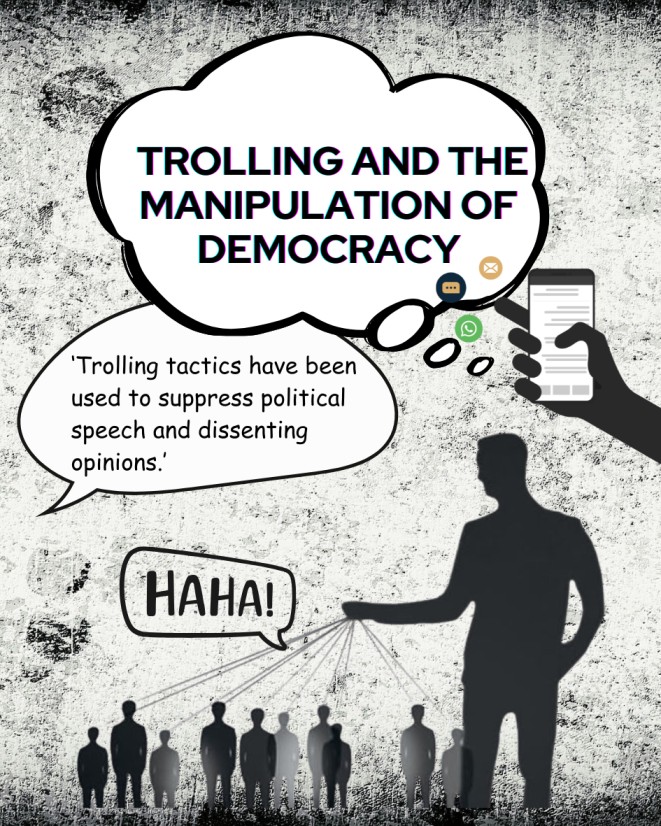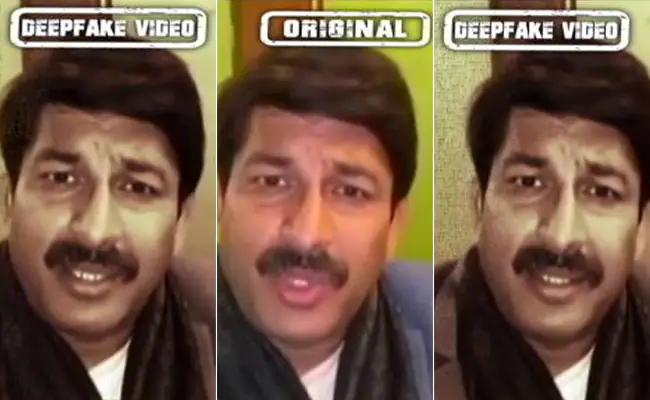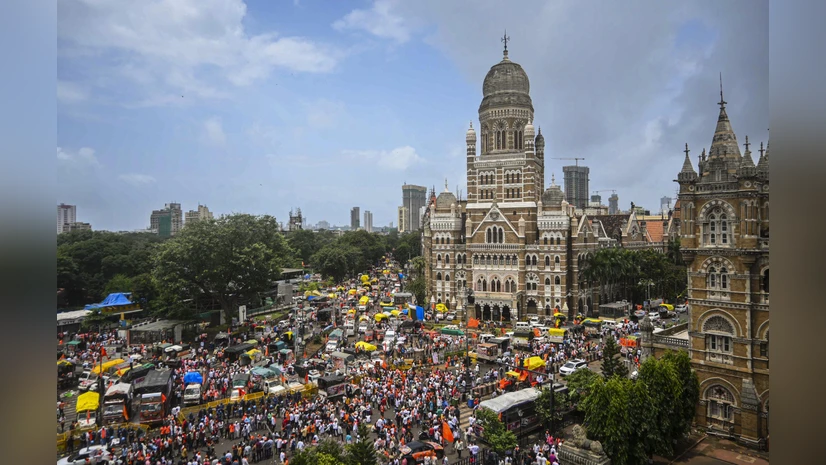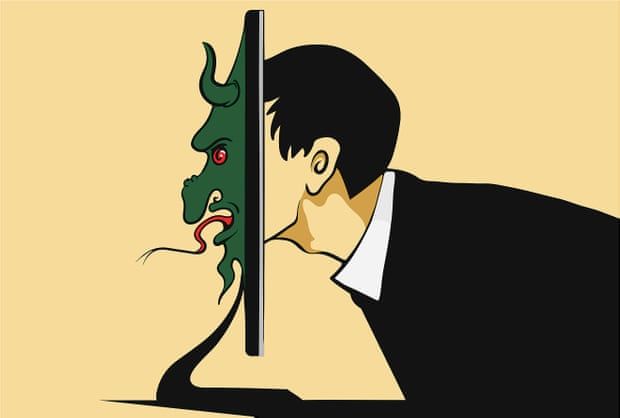The Trolling Culture
Trolling, once considered a mere nuisance or harmless prank in online communities, has escalated dramatically over the past decade, especially in India. Originally, trolling involved individuals posting provocative or off-topic messages for amusement or to provoke reactions. However, with the advent and rapid expansion of social media platforms since the mid-2010s, trolling has transformed into a widespread phenomenon characterised by organised harassment campaigns, misinformation, and targeted abuse. What was once isolated incidents of online mischief is now weaponised for political gains, social control, and the suppression of dissenting voices. This shift has profoundly altered the digital landscape, turning online spaces into arenas where public discourse is frequently distorted by coordinated trolling efforts, which ultimately undermine democratic values and stifle meaningful debate. The normalisation of such cruelty and the strategic use of trolling by political actors has made it one of the most pressing challenges threatening India's digital democracy today.

Trolling has been on the rise in India since the mid 2010s with the rise in the number of users or social media skyrocketing from approximately 90 million in 2014 to over 500 million in 2020. According to studies, nearly 70% of Indians on social networks have encountered or experienced online hatred and harassment, with a clear spike in politically motivated trolling in and after the 2014 general elections. The growing threat of digital harassment that is often unregulated and virtually normalised, exemplifies how trolling has gone from a disparate phenomenon of playful online trickery to a socialisation tool now deeply imbued in everyday life that is used to not only threaten dissenters, but also mislead public opinion and polarise society.
With the entry of Reliance Jio in 2016, India's mobile data rates plummeted dramatically, revolutionising internet access across the country. Before Jio, data prices were as high as 225rs per GB, making the internet unaffordable for many. However, Jio's aggressive strategy offered data at around Rs 12-14 per gb, an almost 95% reduction, making internet access cheap and widespread. This rapid expansion of affordable data, combined with the rise of addictive platforms like TikTok-which captivated millions with short, engaging videos-has led to increased internet addiction across diverse demographics. The combination of low-cost internet and addictive content has massively boosted social media usage, creating fertile ground for trolling and online harassment to flourish unchecked. Political entities have exploited this low-cost, high-penetration digital environment and addictive nature of platforms to amplify their influence and manipulate public narratives.
If you're reading this, it's likely that you've noticed how the internet has become widely available in India, extending accessibility even to those with little formal education or literacy skills. By 2025, more than 800 million people in India gained access to the internet, primarily due to the rise of affordable smartphones and data plans. However, many users still struggle with digital literacy, preventing them from safely and responsibly navigating online spaces. This lack of awareness allows individuals to communicate with large audiences without fully understanding the potential consequences, which facilitates the spread of harmful content and harassment. Consequently, we find ourselves in an open digital landscape where anyone can express their thoughts freely, often without facing consequences, which makes it easier for trolls and harassers to target both individuals and communities.
Internet, Trolling and Politics
The increase of trolling in politics and democracy has become a key area of focus in recent studies. Chat applications are an important platform for spreading misinformation about Indian politics. At least fifty thousand election-related WhatsApp groups were created by both the BJP and INC during the May 2018 Karnataka state elections (Freedom House, 2018). The social media chief of the BJP declared 2018 the year of India's first ‘WhatsApp elections’, and has reportedly “drawn up plans to have three WhatsApp groups for each of India's 927,522 polling booths” (Perrigo, 2019). A so-called cell phone pramukh will operate a number of these groups and drive the party's WhatsApp-based campaign by circulating specially designed campaign material (Uttam, 2018). Parties are even using data analytics to form WhatsApp groups based on demographic and socio-economic factors, using information from the electoral roll to sort the population into groups based on factors such as caste and affluence, to achieve micro-targeted messages (Singh, 2019).
A significant technological development has been the first use of a deepfake video as part of an Indian election campaign. Ahead of the legislative assembly elections in Delhi, on 7 February 2020, two deepfake videos of BJP President Manoj Tiwari criticising the Delhi government were circulated on WhatsApp (Christopher, 2020). This was organised by the Delhi BJP IT Cell and political communications firm The Ideaz Factory. It utilised deepfake technology to create a video in which the politician speaks a local Hindi dialect; Haryanvi. This particular application of deepfakes is part of a campaign to reach different linguistic voter bases. Neelkant Bakshi, of the BJP Delhi IT cell, said the deepfakes were distributed to 5,800 WhatsApp groups in Delhi, reaching fifteen million people (Christopher, 2020).

In the book I am a Troll, Indian journalist Swati Chaturvedi details the creation of the BJP's IT Cell, also known as the ‘BJP troll army’, which was formed in 2007 by Prodyut Bora to smear and threaten opponents online (Dasgupta, 2018). Today, around three hundred workers use “strategies meant to inflame sectarian differences, malign the Muslim minority, and portray Modi as saviour of the Hindus” (Riley, Michael et al., 2018). These attacks vary in their sophistication: from crudely automated criticism, such as #GoBackModi, to highly personalised attacks on individuals.
About 60% of Muslims in India have been exposed to significant online hate, trolling, and Islamophobic abuse on social media platforms. Such sustained digital hostility contributes to a climate where many Muslims feel apologetic, anxious, and obliged to fit in to avoid becoming targets of harassment or violence. Muslim women, in particular, face intense sexualised abuse and targeted harassment campaigns in online spaces. Sulli Deals and Bulli Bai are two well-known examples of this.
In line with their trolling tactics, political differences are exacerbated by inciting Hindu-Muslim tensions on WhatsApp. For example, right-wing Hindu groups circulated a video on WhatsApp depicting a Muslim mob attacking a Hindu woman, but it was footage of a lynching in Guatemala. Automation has also been attempted during the state elections in 2018, the platform's systems detected an attempt by someone in Karnataka to create dozens of WhatsApp groups in quick succession (Goel, 2018). In a very recent case, for example, the Mumbai Police Crime Branch arrested 50-year-old Ashwinikumar Sureshkumar Supra from Noida for allegedly sending a fake bomb threat claiming over 400 kgs of RDX and 34 human bombs were planted in Mumbai. The anonymous message warned of a large-scale terror attack by Pakistani terrorists ahead of the Ganesh Chaturthi festival. This was an orchestrated attempt to malign the muslim identity, a phenomenon that is becoming increasingly common with the ease of access to digital spaces (NDTV news).

What's more troubling is the normalisation of this cruelty; the lack of outrage and the amused spectatorship. Trolling is so embedded in our online experiences now that many users scroll past abuse without flinching, while others may even cheer it on. A few mimic it to avoid becoming the next targets themselves. India's trolling epidemic is not merely a technical glitch or a behavioral quirk. It is a cultural mirror. It reflects how we handle disagreement, process complexity, and treat those who speak differently–with abuse, bullying, and harassment.
The Target of Trolls
Trolls target political opponents and journalists, especially prominent female figures, with sexual harassment and abuse. Sometimes individuals are threatened with real-life physical attacks by online trolls (Gopalakrishnan, 2018). Political parties in particular, have developed sophisticated methods of being able to manipulate and intimidate their critics and opponents with trolls or troll armies online, effectively controlling the narrative. People who challenge their public opinions or create content that counters the narratives these groups build are targeted repeatedly, along with those who witness the abuse. This is a cyclical behavior which silences dissent and discourse in a liberal democratic society. Perhaps another problem is our laws are weak and the judicial process is slow for individuals, making victims vulnerable and celebrating the perpetrators.
While both BJP and INC deny supporting online trolls, these accounts are often aligned with party agendas, and their leaders provide tacit support. For example, Prime Minister Modi follows known troll accounts on Twitter, and once drew criticism for hosting 150 social media influencers at his residence in 2015, many of whom have a history of using sexual slurs to harass women online (Safi, 2018).
The root cause of India's trolling epidemic lies in a mix of unchecked cultural habits, digital architecture, and political exploitation. Trolling in India is no longer considered a fringe nuisance, it has evolved into a mechanism of social control, emotional coercion, and public intimidation, reflecting deeply embedded traditions of public shaming and silencing dissent. This toxic culture has found fertile ground online, where algorithm-driven engagement rewards provocation, and the anonymity of digital spaces enables users to attack with impunity.
Politicians and organised interests further fuel this cycle by leveraging freedom of speech as a shield for orchestrated trolling campaigns, turning digital abuse into a powerful tool for narrative control and the suppression of dissenting voices. With laws lagging behind technology, social media platforms prioritising controversy, and moral accountability eroding, trolling has become normalised, mirroring and magnifying India's challenges in processing disagreement and safeguarding democratic dialogue.

Conclusion
I witness firsthand how deeply politicians, even those who have been rightfully elected, depend on the worst of digital campaigning in order to solidify their spots and rally people. Now, it's nearly standard for leaders to commission or passively tolerate orchestrated trolling campaigns, not simply to promote themselves, but to harass and target anyone who questions their power or challenges their narrative. These concerted online attacks muzzle critics, silence marginalised voices, and render dissent an ever more dangerous choice.
Polarisation is both an effect and a cause of trolling, which intensifies social polarisation by deepening echo chambers that confine individuals within ever-narrower ideological bubbles. Marginalised groups, who ought to benefit from the democratising power of online environments, are disproportionately silenced and targeted, perpetuating existing inequalities in addition. New opportunities for advanced manipulation technologies, such as deepfakes, create new difficulties in distinguishing between fact and fiction and depleting citizens' ability to critically evaluate. Such an environment of confusion emboldens politicians and actors who are able to use disinformation to shift blame-a so-called “liar's dividend”. It is terrifying to see how rapidly these tactics build up: professional troll brigades, bots, and loyalists from each party joining together to overwhelm their opponents and instigate division. Politicians resort to these illegitimate ways, particularly as public discourse on social media grows more polarised and toxic.
From high-profile political wars to local grassroots campaigns, this dependence on online harassment more than just influences public opinion; it undermines the democratic ethos by pushing honest speakers off the podium and substituting real debate with threats and terror. Until political leaders not only condemn these strategies but actually disassemble them, democracy will be susceptible to manipulation, and civic engagement will be threatened by the very tools intended to enable it.
Resources
- Datareportal. (2025). Digital 2025 India Report.
- World Economic Forum. (2023). How Smartphones Can Boost Digital Literacy Among India's Rural Communities.
- Countercurrents. (2025). The Rise of Online Trolling in India: A Culture Shaped by Contempt.
- Oxford Internet Institute. (2019). India Profile.
- Oxford Internet Institute. (2019). Case Studies Collated.
- Vice. (2023). The First Use of Deepfakes in Indian Election by BJP.
- Huffington Post. (2018). It's Like Frankenstein's Monster: The Father of the BJP's IT Cell.
- Vice. (2023). The First Use of Deepfakes in Indian Election by BJP.
- India Today. (2025). Noida Man Held for Hoax Bomb Threat in Mumbai.
- Frontiers in Communication. (2024). Article on Communication.
- CSO Hate. (2025). Report on Social Media and Hate Speech in India.
- The Hindu. (2025). Sulli Deals, Bulli Bai, and the Young and Educated Hatemongers.
- BBC News. (2022). News on India.
- Amazon. (2021). I Am Troll: Inside the Digital.
- Datareportal. (2025). Digital 2025 India Report.
- World Economic Forum. (2023). How Smartphones Can Boost Digital Literacy Among India's Rural Communities.
- The Guardian. (2018). Indian Foreign Minister Sushma Swaraj on Trolls and Social Media.